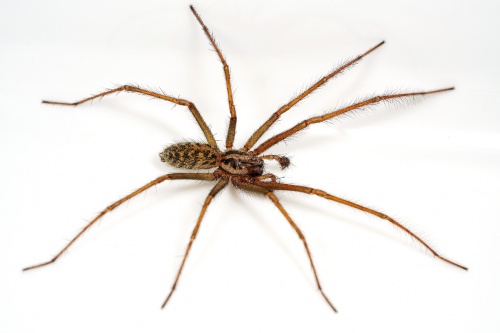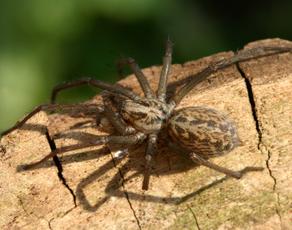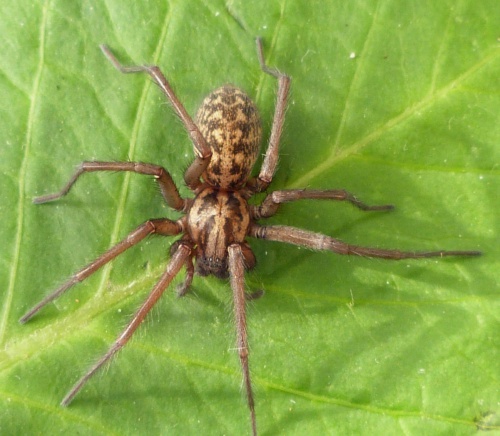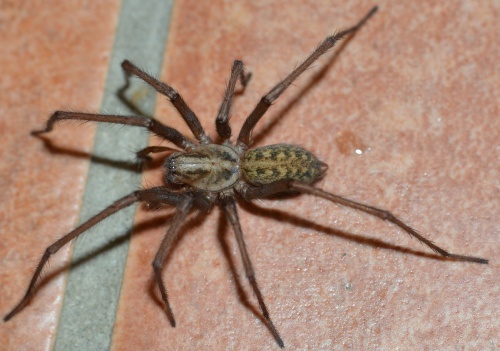Giant house spider Biology
The giant house spider, Eratigena atrica (formally known as Tegenaria gigantea and T. duellica), is commonly found in and around Washington homes west of the Cascade Mountains. Its range also includes parts of coastal Canada and Oregon. They are not found east of the Cascades in Washington.
It is often seen in mid-summer to early fall, when males in particular are highly mobile. These brown to grayish-brown spiders are highly variable in size and color. The body is typically around 1/2 inch to 1 inch in length (not including the legs); while the leg span for large adults can reach up to 4 inches. The smaller males are often mistaken for hobo spiders; however, in the Puget Sound region giant house spiders outnumber hobo spiders and are much more frequently encountered.

The legs and body of the giant house spider are somewhat hairy and are not shiny in appearance. The color varies widely from light to dark, with markings on the body and legs ranging from barely visible to very distinct. Because of the variability in color, size, and markings, none of these are reliable features for identifying this spider. Giant house spiders prefer dark areas for web-building and are ideally adapted to life indoors. They are often found in garages or basements, as well as outdoors in firewood or in gaps between bricks or stones. They build sheets of webbing with a funnel-like hole in the center, where the spider sits waiting for prey. The giant house spider is not an extremely active climber and indoors is usually found on the floor or trapped in sinks or bathtubs where it has ventured in search of water. These spiders are not aggressive and usually run away (very quickly) when startled.
The bite of the giant house spider is not known to pose any threat to humans. However, if you are bitten by a spider, bring the spider to an expert for correct identification and you may wish to seek medical attention. Spiders are considered beneficial because they are predators. However, they can also be a nuisance pest indoors. Giant house spiders are frequently mistaken for hobo spiders.
The giant house spider is one of our fastest invertebrates, running up to half a metre per second. This large, brown spider spins sheet-like cobwebs and pops up in the dark corners of houses, particularly in autumn.
How to identify:The giant house spider is one of several very similar species of house spider. As a group, their long-legs, dark hairy bodies and preference for houses and buildings make them unmistakeable.
Giant house spider size:
Body length: up to 1.6cm
Leg span: up to 7.5cm
The giant house spider is the larger cousin of the House spider (Tegenaria domestica), and can be found living behind the fireplace, under the sofa, or in the bath. Giant house spiders are particularly prevalent in the autumn when the males are out looking for females. The males stay with their chosen females for some weeks, mating numerous times until eventually they die, at which point they are eaten by their female. Giant house spiders spin sheet-like cobwebs in neglected corners of the room and wait close by for unsuspecting insects to get caught; they are most active at night.


Females can reach 18 mm in length, with males having a slightly smaller body at around 12 mm to 15 mm in length. The female leg span is typically around 45 mm. The leg span of the male is highly variable, with spans between 25 mm to 75 mm being common. The former genus Tegenaria has recently been split: Tegenaria spp. have banded legs, Eratigena spp. have plain legs. Beyond this distinction, species can only be identified (with difficulty) by examination of the genitals of mature specimens.
Giant House Spiders in Michigan
The giant house spider is very common in Michigan. It was at one time thought to be venomous, but was proven to have little or no venom toxicity. The giant house spider can be found in dark corners of rooms, storage sheds, barns, bridges, fences, and other structures. This large spider generally constructs funnel webs on window angles and in corners. Although giant house spiders prefer to live outdoors, they are hitchhikers and can be brought indoors when they hide in boxes, firewood, or other belongings.
Giant House Spider Habitat
They are often found in garages or basements, as well as outdoors, in firewood, or in gaps between bricks or stones. They build webs with a funnel-like hole in the center, where they sit and wait for prey. The giant house spider is not an active climber and indoors can be found on the floor or trapped in sinks and bathtubs where it has ventured in search of water. They prefer to avoid contact with humans and hide during the day, meaning they are most often seen at night.
Giant House Spider Behaviors, Threats, or Dangers
Giant house spiders are most often spotted indoors during the autumn when they have reached their maximum size. These spiders are not aggressive and usually run away, very rapidly, when startled. Although it is rare, a bite from a giant house spider may occur when it feels threatened. However, bites are not serious and the giant house spiders’ venom is only harmful to individuals with specific allergies. Aside from its large size and threatening appearance, this spider does not pose much of a threat to people. Always contact a professional spider exterminator for help with giant house spiders.
Everything You Need to Know about the Giant House Spider
The Giant House Spider, scientifically known as Eratigena atrica, is a species of arachnid that has gained notoriety due to its size and speed. Despite its intimidating appearance, this creature plays a vital role in maintaining the balance of our ecosystem. Let’s delve into the fascinating world of this large eight-legged creature and dispel some of the myths surrounding it.
An Introduction to the Giant House Spider
The Giant House Spider is a well-known arachnid that belongs to the Agelenidae family. It is recognized as one of the fastest spiders due to its ability to move at a speed of up to half a meter per second.
Contrary to its fearsome name and appearance, the Giant House Spider is generally harmless. It’s known for its sizable and complex webs, usually found in the darker, undisturbed corners of houses and buildings.

Size and Appearance
The Giant House Spider is one of the largest spider species in Central and Northern Europe. Female spiders can have a body size reaching 18.5 millimeters (0.73 in) in length, while males have a slightly smaller body, around 12 to 15 millimeters (0.47 to 0.59 in) in length.
The spider’s coloration is primarily dark brown, with a lighter marking on its sternum. The females are not distinguishable from the males in terms of coloration or markings. Their abdomen features a pattern of lighter spots forming an arrow-like shape pointing towards the spider’s head.
Speed
One remarkable characteristic of the Giant House Spider is its speed. It was once listed in the Guinness Book of World Records as the world’s fastest spider, capable of reaching speeds of up to 1.2 miles per hour or 0.53 m/s.
Habitat and Distribution
The Giant House Spider is found across Europe, Central Asia, and Northern Africa. It was accidentally introduced to the Pacific Northwest of North America around 1900 due to human activity.
Interestingly, the species has been discovered in several European countries where it was previously not recorded, such as Estonia, Latvia, and Lithuania.
As the name suggests, the Giant House Spider is often found in houses, specifically in places rarely disturbed by humans, such as basements, attics, and behind cupboards. Their original habitat consists mostly of caves or dry forests where they reside under rocks.
Behavior and Diet
The Giant House Spider is a nocturnal creature, which means it is most active during the night. It constructs flat and messy webs, usually with a funnel at one end. The spider stays in the funnel until a small invertebrate gets trapped in the web, at which point it rushes out to attack.
Its diet mainly consists of insects, which it captures in its web. They play a significant role in controlling pests within households by preying on fleas, mosquitoes, flies, and other insects.
Life Cycle
Giant house spiders go through a series of development stages from an egg into a mature adult. The female spider lays eggs in a sac hidden within the web. The spiderlings, or baby spiders, emerge from the egg sac and remain together for about a month. They molt seven or eight times before reaching maturity.
Giant House Spider in North America
The Giant House Spider is not native to North America. It was accidentally introduced to the region around the early 1900s. Since then, it has become a common sight in homes, particularly in the Pacific Northwest.
It’s worth noting that the Giant House Spider is not considered a significant threat to humans or pets. Regardless of their size and speed, they are generally reluctant to bite and prefer to hide or escape when confronted.
The Biggest Giant House Spider
The size of the Giant House Spider can vary, but the females are usually larger than the males. The body of a female Giant House Spider can reach up to 18.5 millimeters in length, with a leg span of around 45 millimeters. The leg span of the male is highly variable, with spans between 25 and 75 millimeters being common.

Taxonomy and Species
The taxonomy of the Giant House Spider has been a subject of debate among arachnologists. Initially, it was treated as a single species under the name Eratigena atrica. However, subsequent genetic studies identified three distinct morphological groups, leading to the restoration of three separate species: E. atrica, E. duellica, and E. saeva.
Giant House Spiders and Humans
Despite their unnerving size and speed, Giant House Spiders pose no significant threat to humans. Their bite, while rare, is not dangerous to humans, and they are generally reluctant to bite. Instead, they play a vital role in controlling pests inside homes.
However, if a Giant House Spider infestation becomes an issue, professional pest control services can be employed. Preventative measures such as sealing cracks and gaps in the home’s exterior and reducing outdoor lighting that attracts insects can also be beneficial.
The Giant House Spider, while intimidating in appearance, is a largely misunderstood creature. Its significant size and rapid speed often cause unnecessary fear. However, these spiders are generally harmless and play a crucial role in maintaining the balance of our ecosystem. By understanding their behavior, habitat, and role in the environment, we can learn to coexist with these fascinating creatures.
